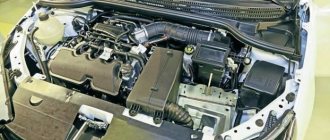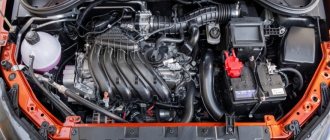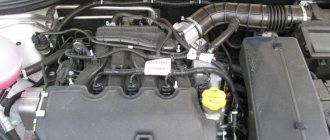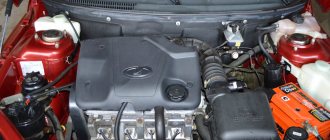Specifications
power 21129 (127) – 106 hp. (21126 – 98hp)
Torque 21129 (127) – 150 N.m (21126 – 145 N.m.) at 4000 rpm.
Mixed fuel consumption is 7-10 liters per 100 km. More details about fuel consumption
Recommended fuel – AI 95
Motor weight – 115 kg.
The table above shows the torque and power graph of the 1.6L 21129 engine and its comparison with the 21179 1.8L engine.
How to reduce fuel consumption
When the Lada Xray and other models reach 45,000 mileage, it is necessary to check the functionality of the thermostat, the elasticity of the cooling system pipes and replace the antifreeze. I mainly take orders for cargo transportation, but even when there is not enough cargo transportation work, I can take passengers and, taking into account the fact that the average fuel consumption in the city is 11 liters, I will not go into the red.
Oil
The oil used in this engine is similar to 21126: synthetic, semi-synthetic
5W-30 5W-40 10W-40 15W40
Oil sump volume
This point will be useful for those who are going to change the engine oil. With different transmissions, the volume of oil poured into the engine is also different.
VAZ 21129 + Renault manual transmission (cast crankcase) = 4.4l
VAZ 21129 + robot (stamped crater) = 3.2 l
The engine resource is 200 km. But in practice, you need to monitor the condition of the roller, pump and timing belt, because if individual valve elements jam, they will meet the piston group, and then both will come to an end. In addition, during the impact of these elements, it is not uncommon that the crankshaft bends slightly. You can drive with such a crankshaft, but there will be huge oil consumption.
Features of 21129 engine/differences
The main feature of the 129 engine is the “innovative” for AvtoVAZ installation of an intake receiver with variable chamber geometry and volume. Due to the damper, the volume of the intake chamber changes depending on the speed. As practice shows, the damper is activated at 3500 engine speeds.
In addition, the engineers managed to get rid of the mass air flow sensor - mass air flow sensor. Along with him, his ailments went away, which tormented the owner of the 21126 engine: unstable idling, sometimes exorbitant consumption, high cost. Instead of mass air flow sensors, engineers installed a connection from DBP and DTV sensors (atmospheric pressure and air temperature sensors). This is where the differences from the 126 engine end. Speaking in fact, the intake system with variable geometry is as old as the world and has been installed by global manufacturers almost since the 80s.
Differences 21129 from 21126 (mounted layout, transition from mass air flow sensor to DBP+DTV, presence of an intake receiver with variable geometry.
Differences between 21129 and 21127 (Different layout, different firmware)
Comparison of configurations and prices
Renault Docker is sold on the Russian market in three trim levels, differing from each other in power units and the presence of one or another additional equipment. At the same time, for the simplest version in the showrooms of an official dealer they ask about 900,000 rubles. But even in this option, the car will have everything you need to ensure minimal comfort and safety.
Its rival Lada Largus offers buyers a choice of six trim levels: Classic, Comfort, Standard, Luxe, Luxe Prestige and CNG Luxe. The versions differ in engine type and additional options. In addition, the car can be purchased in both a five-seater and a seven-seater version. His opponent does not have such an opportunity, nor does he have such a wide choice of configurations. And a Russian car costs an order of magnitude cheaper than a French one. In its minimum configuration, it can be purchased for about 620,000 rubles. But at the same time, the equipment of such a station wagon will be slightly worse than the French one in the cheapest version.
Engine tuning 21129
Tuning the 21129 engine is no different from the 126 engine.
Easy tuning : Euro-2 or Euro-2 firmware + installation of 4-2-1 exhaust
Medium tuning : Exhaust 4-2-1 + Shafts + firmware (preferably flashed online)
Deep : includes modification of the head, replacement of valves, pushers, etc. All technical characteristics of Vesta.
Lada Largus engines are 8- and 16-valve gasoline units. It's no secret that the domestic Lada Largus is nothing more than the first generation Renault Logan. Accordingly, the engines there are from Renault, but not everything is so simple. After all, since December 2015, the manufacturer decided to replace the 8-valve engine with 84 hp. ( Renault K7M ), on the domestic eight-valve VAZ-11189 with a power of 87 hp. In addition, the 16 valve Renault K4M (105 hp), which was previously imported from Europe, is now produced at Avtovaz and produces only 102 hp. But the drop in power of the 16-valve engine is not due to any design changes, but to the reconfiguration of the injection system to comply with the more stringent Euro-5 environmental standard. Today we will talk about all Lada Largus engines.
Comments
Guests cannot leave comments on the site, please log in.
Products for LADA at the best price
A selection of accessories for LADA from AliExpress
Since 2022, Renault engines have completely stopped being installed on Lada Largus station wagons. The K4M engine was replaced by the VAZ 21129 (16 valves). Two years earlier, in 2015, AvtoVAZ similarly abandoned the K7M engine in favor of the VAZ 11189 (8 valves).
The reason for the replacement is the cost of the motors. Domestic internal combustion engines are cheaper. But AvtoVAZ decided not to reduce the price of the Lada Largus, but to make the car more comfortable. The package includes athermal glass, a cabin air filter, a belt sensor, etc.
As part of the article, we will look at all 4 engines that were installed on the Lada Largus. K7M, K4M, VAZ 11189 and VAZ 21129.
The K7M (8 valves) and K4M (16 valves) engines are representatives of the same series. With timely maintenance, they show an excellent service life (over 400 thousand km). But if you skip maintenance, both engines can give you an unpleasant surprise. For example, both K7M and K4M bend valves when the timing belt breaks. Therefore, it is recommended to change the belt every 60 (or better yet, 50 thousand km).
More details about K7M (8 valves)
Initially, the eight-valve K7M had 86 hp. with a volume of 1.6 liters. But in 2010 it was modified to meet the Euro-4 standard, and it lost 3 horsepower.
K7M has a simple and reliable design. With timely care, it can travel up to 500 thousand km. You just need to change the timing belt, tension rollers on time and not skip maintenance.
Engine weaknesses:
- High fuel consumption - 12.3 l/100 km in the city.
- Weak power and dynamics.
- Strong noise and vibration during operation.
- It is necessary to adjust the valves every 25-30 thousand km.
K7M is a demanding engine with high fuel consumption and poor dynamics. 83 hp not enough for a comfortable ride in Lada Largus. The lack of horsepower is especially noticeable when driving outside the city.
More details about K4M (16 valves)
Improved version of K7M. Volume 1.6. liters and 102 hp It adopted the problems of the previous version - high fuel consumption and high maintenance requirements. But it boasts much better driving dynamics. Installed in the “Lux” configuration.
Engine weaknesses:
- High fuel consumption ¬ 11.7 l/km in the city.
- Expensive spare parts.
- Possible failures in operation due to low-quality fuel.
- It often troits (usually the problem is in the ignition coil, injectors or spark plugs).
With timely maintenance, the engine, like the K7M, can travel more than 400 thousand km.
French engines K7M and K4M are obsolete, but they are still extremely reliable in operation. If a person is ready to put up with high fuel consumption and the need to regularly visit a car service center, the Lada Largus with such an engine will be an excellent choice.
If we compare only 2 Renault engines, then the K4M wins. It is more dynamic, more powerful and easier to maintain.
Both engines (VAZ 11189 and 21129) differ from their French predecessors in increased power, better traction at low speeds and reduced fuel consumption. Just like K7M and K4M, VAZ engines bend valves when the timing belt breaks. According to the regulations, the belt should be changed every 180 thousand km, but Lada Largus owners advise visiting a service every 60 thousand km.
More details about VAZ 11189 (8 valves)
The VAZ 11189 engine has 87 horsepower (K7M has 83 HP) and a maximum torque of 140 Nm (K7M has 124 Nm). It is a modified version of engine 11186 to meet Euro-4 standards.
In comparison with the French analogue, it has better traction at low speeds, maintains dynamics even under heavy load and runs “quieter”. This is achieved due to a lightweight connecting rod and piston group.
Strengths:
- Reduced fuel consumption – 9.1 l/km in the city (instead of 12.3 l/km).
- Better dynamics during acceleration and traction at low speeds.
- It is quieter than its predecessor from Renault.
- Relatively inexpensive spare parts.
The engine runs on AI-92 and AI-95 gasoline. But car owners note that it is better to refuel the 95th. Driving on 92 gasoline increases fuel consumption and reduces acceleration dynamics.
Common problems with ICE 11189:
- The revolutions are floating. Usually the problem is explained by a sensor failure; first of all, you need to check the E-gas electronic throttle actuator.
- Troit. Due to malfunctions in the ignition system, the engine may start to stall. If everything is in order with the ignition system, then you need to check the valves.
- Overheat. The VAZ 11189 has a very unreliable thermostat.
Most problems are explained by the refusal of scheduled maintenance. With timely maintenance and checking of sensors, the ICE 11189 operates stably and shows excellent results.
More details about VAZ 21129 (16 valves)
ICE 21129 – adaptation of the 21127 engine to Euro-5 standards. It was created for the Lada Vesta and X-ray models and has already stood the test of time.
Strengths:
- Reduced fuel consumption – 9.5 l/km in the city (instead of 11.7 l/km).
- Improved dynamics during acceleration.
- Quiet operation.
Engine 21129, like 11189, can run on AI-92. But it is recommended to fill in 95 gasoline. At 92, fuel consumption increases and dynamics deteriorate.
Common problems with internal combustion engine 21129:
- Overheat. The engine does not have the most reliable thermostat.
- Troit. The engine may stall due to faulty spark plugs, coils or clogged injectors.
- Knock under the hood. On some cars, hydraulic compensators make noise; they can be replaced at the dealer under warranty.
In the technical documentation for the car, the timing belt life is indicated as 180 thousand km. But it is better to change it every 60 thousand km. Even if the belt serves the specified period, which often does not happen, the idler pulley and water pump may jam. And if the timing belt 21129 breaks, the valve bends.
Domestic engines are superior to their French predecessors. Cars with VAZ engines accelerate faster, pull better at low speeds, are quieter and have lower fuel consumption.
Both domestic engines installed on the Lada Largus are modifications of older models. They have already stood the test of time and proven their competitiveness. Thanks to the reduction in the cost of engines, AvtoVAZ added to the car's equipment - athermal glass was added, an improved vacuum brake booster, the windshield wiper mechanism was changed, additional sensors appeared, etc. The car became more comfortable, but the price remained the same.
VAZ 11189 and 21129 have an important advantage. Spare parts for them are cheaper than for French engines. All internal combustion engines installed on Largus require careful maintenance and monitoring, but driving a car with a domestic engine is cheaper.
To make the price of spare parts and service even cheaper, order them from Largus Shop with free delivery. We regularly hold promotions and give discounts to regular customers.
- Published by: Pavel Ivanov
- Date: Monday, January 20, 2020
So, it is important to know what engines are installed on Largus, the technical differences and features of the power plant. Let's start with the fact that the first cars were equipped with engines: 8-valve Renault-Nissan K7M and 16-valve Renault-Nissan K4M.
Today, cars are equipped only with domestic engines: 8-valve VAZ 11189 and 16-valve VAZ 21129. Let us examine in more detail all Lada Largus engines, their technical characteristics and assembly features.
On the Lada Largus, the Renault-Nissan K7M engine (8 valves) with a volume of 1.6 liters and a power of 82 horsepower (60 kW) is a gasoline engine on versions of cars in the “norm” and “standard” configurations. Cars with the luxury package are equipped with Lada Largus 16-valve Renault-Nissan K4M gasoline engines with a displacement of 1.6 liters and a power of 102 horsepower (75 kW).
Since December 2015, instead of the Renault-Nissan K7M gasoline engine, cars began to be equipped with an 8-valve Lada Largus VAZ 11189 engine with a volume of 1.6 liters and a power of 87 horsepower (64 kW).
Since October 2022, the Largus Renault K4M gasoline engine has replaced the Largus 16 valve VAZ 21129 with a volume of 1.6 liters and a power of 106 horsepower (78 kW). Please note that engines produced by Renault-Nissan comply with Euro 4 environmental standards, and engines from the VAZ manufacturer comply with Euro 5 environmental standards.
Options for installing additional equipment on the internal combustion engine of a Lada Largus car:
- non-power steering;
- non-power steering with climate control;
- hydraulic power steering (power steering);
- air conditioning and hydraulic power steering.
Engine design Lada Largus 1.6 8 valves
The Renault K7M gasoline engine at Largus produced 84 hp. Structurally, it is a four-stroke, four-cylinder, in-line, eight-valve, with an overhead camshaft. The operating order of the cylinders is: 1–3–4–2, counting from the flywheel. The engine power system is MPI distributed fuel injection. The engine, gearbox and clutch form the power unit - a single unit mounted in the engine compartment on three elastic rubber-metal supports. The right support is attached to the bracket on the top cover of the timing belt, and the left and rear ones are attached to the gearbox housing. The engine cylinder block is cast from cast iron, the cylinders are bored directly into the block. The nominal cylinder diameter is 79.5 mm. The engine was assembled at the Romanian Dacia plant.
Exterior
The basic Largus equipment includes central locking with an immobilizer, one airbag for the driver, manual windows, ISOFIX mounts, mud flaps on the front wheels and stamping. Engine view from the right in the direction of vehicle travel 1 auxiliary drive belt; 2 auxiliary drive pulley; 3 cylinder block; 4 lower heat shield of the exhaust manifold; 5 upper heat shield of the exhaust manifold; 6 control oxygen concentration sensor; 7 exhaust manifold; 8 lower cover of the gas distribution mechanism drive; 9 upper cover of the gas distribution mechanism drive; 10 throttle assembly; 11 receiver; 12 power steering pump pulley; 13 belt support roller; 14 generator; 15 belt tensioner roller; 16 air conditioning compressor pulley; 17 oil pan.
Cylinder head of engine Lada Largus 1.6 8 valves
The cylinder head of the Lada Largus 1.6 is cast from aluminum alloy, common to all four cylinders. It is centered on the block with two bushings and secured with ten screws. A non-shrinking metal gasket is installed between the block and the head. There are five camshaft supports (bearings) located at the top of the cylinder head. The supports are made one-piece, and the camshaft is inserted into them from the timing drive side. The camshaft is driven by a toothed belt from the crankshaft.
Options and prices: almost a monopoly
At the moment, for the current Lada Largus there are 4 configurations to choose from. Moreover, the first two versions are available in the cargo-passenger van version without rear glazing. Starting with the second Classic option, by paying an additional 23 thousand rubles to the price, you can get a third row of seats for additional seating for two people. The flagship 16-valve engine is an integral part of the passport data from the third configuration Comfort and higher.
Classic
The basic Classic version starts at 690,900 rubles. Such a low price is due to the minimal set of equipment. The equipment of the initial Largus includes only an adjustable steering column and a 50/50 folding rear sofa. Passive safety is provided only by the front driver's airbag. But for an additional fee, the body can be painted with metallic enamel.
Comfort
The Comfort package next on the list (see tables) is already capable of offering the necessary subsistence level. Buyers of this Lada receive: air conditioning, front power windows, power steering, central locking, heated seats, anti-lock brakes and a folding (60/40) second row. By purchasing Largus Comfort, the owner pleases himself with: a car radio with MP3, hands free and bluetooth telephone, remote control for central locking and a passenger airbag.
Luxe and Prestige
The Luxe version includes such useful things as height adjustment of the driver's seat, heated rear-view mirrors with a servo drive, an on-board computer, parking sensors, fog lights and power windows in the rear. Well, the flagship Prestige package gives the top Lada model only aluminum wheel rims.
Timing drive of engine Lada Largus 1.6 8 valves
The timing drive on the Lada Largus 1.6 8 valves is carried out according to the following scheme (image just above) - torque from the crankshaft pulley is transmitted to the camshaft pulley, rotating the coolant pump pulley. The belt is tensioned with a special roller, which changes along with the timing belt. If the belt breaks, the valve bends. The belt must be replaced every 60 thousand kilometers.
Technical characteristics of the engine Lada Largus 1.6 8 valves
- Working volume – 1598 cm3
- Number of cylinders – 4
- Number of valves – 8
- Cylinder diameter – 79.5 mm
- Piston stroke – 80.5 mm
- Timing drive - belt
- Power hp (kW) – 84 (62) at 5500 rpm. per minute
- Torque – 124 Nm at 3000 rpm. per minute
- Fuel type – gasoline AI-92
We will not talk in detail about the Russian VAZ-11189 engine, which today replaced the previous 8-valve engine under the Largus hood. Since the motor is quite common and is found on many Lada models. Structurally, the unit originates from the first front-wheel drive VAZ-2108. 4-cylinder naturally aspirated, with a cast-iron cylinder block and a timing belt. Unit power 87 hp. (64 kW) at 5100 rpm. Torque is 140 Nm at 3800 rpm. The engine is designed for AI-92 gasoline.
Description of the K7M engine (Renault Logan/Sandero/Largus)
In 2010, the K7M 800 engine appeared, which replaced the K7M 710. No design changes occurred, except that the engine was strangled, bringing it up to the Euro-4 environmental standard, while the power decreased from 86 hp to 83 hp. With.
The disadvantages of the engine remain the same:
- high fuel consumption.
- At idle the speed often fluctuates.
- Every 20-30 thousand km the valves need to be adjusted.
- no hydraulic compensators.
- If the belt breaks, the valve bends; it is recommended to change the belt every 60 thousand km.
- crankshaft oil seal leaking.
- the engine is noisy.
- there are vibrations during operation.
If you look at the engine from the positive side, it is worth noting its high reliability; according to the passport, the engine life is about 400 thousand km, but in practice it is a little more.
Engine structure Lada Largus 1.6 16 valves
The Largus engine is Renault K4M with a power of 105 horses, which, after “reflashing the brain,” began to comply with Euro-5 and produce 102 hp. Initially, the engine was brought from Spain (from the Renault plant), but now it is produced with a high degree of localization in Tolyatti. This is a 4-cylinder 16 valve unit with distributed fuel injection and a timing belt. The base is a cast iron block. The cylinders are bored directly into the block. The operating order of the cylinders is: 1–3–4–2, counting from the flywheel.
How does “Lux / 5 seats” differ from “#Club / 5 seats”
Differences Lada Largus “Lux / 5 seats”
- Fog lights
- On-board computer
- Interior to choose from: black or brown
- Luggage rack on the roof lining
- Trunk tension shelf
- Adjusting the height of the front seat belts
- Driver's seat with height adjustment
- Driver's seat with lumbar support
- Central locking control panel in the key
- Rear electric windows
- Electrically adjustable side mirrors
- Heated side mirrors
- Exterior mirrors in body color
- Exterior door handles in body color
- Wheels 15-inch
- Steel wheels
- Spare wheel 15-inch full size
Differences Lada Largus “#Club / 5 seats”
- Interior black
- Enhanced rear window tinting
- Wheels 16-inch
- Original light alloy wheels
- Spare wheel 15-inch small
Cylinder head of Lada Largus K4M engine
The block head of the Lada Largus 1.6 liter engine (16 valves) is aluminum with two camshafts and hydraulic compensators. That is, the thermal clearance of the valves does not need to be adjusted manually. And all thanks to the hydraulic supports of the valve levers, which are installed in the cylinder head sockets. A hydraulic compensator with a check ball valve is installed inside the hydraulic support housing. Oil enters the hydraulic mount from the line in the cylinder head through a hole in the hydraulic mount housing. The hydraulic support automatically ensures backlash-free contact of the camshaft cam with the valve lever roller, compensating for wear of the cam, lever, valve stem end, seat chamfers and valve plate.
Timing drive of engine Lada Largus 1.6 16 valves
The Lada Largus 1.6 camshafts are driven by a toothed belt from the crankshaft pulley. On the shaft, next to the first (counted from the camshaft gear pulley) support journal, there is a thrust flange, which, during assembly, fits into the grooves of the cylinder head and cover, thereby preventing axial movement of the shaft. The camshaft pulley is not fixed to the shaft using a key or pin, but only due to the friction forces that arise on the end surfaces of the pulley and shaft when the pulley fastening nut is tightened. A belt rupture or jumping several teeth usually leads to disastrous consequences, because this engine definitely bends the valve . The timing belt is replaced every 60 thousand kilometers or after 4 years, whichever comes first, regardless of its condition.
Technical characteristics of the engine Lada Largus 1.6 16 cl.
- Working volume – 1598 cm3
- Number of cylinders – 4
- Number of valves – 16
- Cylinder diameter – 79.5 mm
- Piston stroke – 80.5 mm
- Timing drive - belt
- Power hp (kW) – 102 (75) at 5750 rpm. per minute
- Torque – 145 Nm at 3750 rpm. per minute
- Maximum speed – 165 km/h
- Acceleration to the first hundred – 13.5 seconds
- Fuel type – gasoline AI-95
- Fuel consumption in the city – 10.1 liters
- Fuel consumption in the combined cycle – 7.9 liters
- Fuel consumption on the highway – 6.7 liters
JH3 reliability
The JH3 gearbox is considered a reliable unit, therefore it is still relevant in the automotive market. Car owners prefer cars with a structurally simple gearbox, partly because of its accessible and cheap maintenance. The disadvantages of manual transmission boil down to the lack of a high level of driving comfort. The gear shift does not always occur clearly and quickly; sometimes there are jolts and jerking of the vehicle. Structurally, the unit has been fully studied, so even in the event of a serious breakdown, its overhaul will not be difficult. Usually the lever for switching from one speed to another becomes loose ahead of time, which leads to unclear switching.
Often, owners of Lada Largus with JH3 note the noisy operation of the manual transmission and a crunching sound when engaging reverse mode. Early wear of the synchronizers cannot be ruled out. If we close our eyes to some shortcomings, we will get decent mechanics that can go 200-300 thousand km without a single repair. There are known examples of cars that have covered about 500 thousand km on JH3 without a single repair. Much depends on your driving style and quality of service. The oil change must be carried out in accordance with the maintenance regulations.
Characteristics of motor 21129
On the one hand, the 21127 engine, which served as the base version for the creation of 21129, is in turn a tuned modification of 21126, so most of the components in the engine remained the same to reduce production costs. From another point of view, the manufacturer took into account the disadvantages of upgrading its subsidiary to the ICE 21128, so the final engine diagram looks like this:
- the cylinder diameter and piston stroke remained classic for front-wheel drive engines - 82 mm and 75.6 mm, respectively;
- the gas distribution mechanism of the engines remained unchanged - DOHC with two overhead camshafts;
- the cylinder head, connecting rod-piston group and cylinder block have not undergone any changes;
- the entire intake tract with an integrated receiver, DBP and DTV sensors instead of the mass air flow sensor has been preserved;
- the attachments have been partially changed - new pillows, generator and exhaust manifold;
- The engine cooling system and fuel injection have been improved.
The most important feature of 21129 was the new version of the ECM firmware - M86. As a result, gasoline consumption decreased, torque and power increased to 148 Nm and 106 hp. s., respectively. That is, the modernization did not affect the volume of combustion chambers of 1.6 liters.
A full description of the motor parameters is given in the instructions, and the main technical characteristics of 21129 are contained in this table:
| Manufacturer | AvtoVAZ |
| Engine brand | 21129 |
| Years of production | 2015 – … |
| Volume | 1597 cm 3 (1.6 l) |
| Power | 78 kW (106 hp) |
| Torque moment | 148 Nm (at 5800 rpm) |
| Weight | 110 kg |
| Compression ratio | 10,5 |
| Nutrition | injector |
| Motor type | in-line |
| Injection | distributed electronically controlled |
| Ignition | coil for each spark plug |
| Number of cylinders | 4 |
| Location of the first cylinder | TVE |
| Number of valves on each cylinder | 4 |
| Cylinder head material | aluminum alloy |
| Intake manifold | combined with receiver, polymer, built-in damper, DTV and DBP sensors |
| An exhaust manifold | catalyst |
| Camshaft | 2 pcs., marks on pulleys are offset by 2 degrees |
| Cylinder block material | cast iron |
| Cylinder diameter | 82 mm |
| Pistons | lightweight, manufacturer Federal Mogul |
| Crankshaft | from 11183 |
| Piston stroke | 75.6 mm |
| Fuel | AI-95 |
| Environmental standards | Euro 5 |
| Fuel consumption | highway – 5.3 l/100 km mixed cycle 6.6 l/100 km city – 9 l/100 km |
| Oil consumption | maximum 0.1 l/1000 km |
| What kind of oil to pour into the engine by viscosity | 5W-30 and 10W-40 |
| Which engine oil is best by manufacturer | Liqui Moly, LukOil, Rosneft, Mannol, Mobil |
| Oil for 21129 according to composition | synthetics, semi-synthetics |
| Engine oil volume | 3.5 l |
| Operating temperature | 95° |
| Motor life | declared 200,000 km actual 300,000 km |
| Adjustment of valves | hydraulic compensators |
| Cooling system | forced, antifreeze |
| Coolant quantity | 7.8 l |
| water pump | with metal impeller |
| Candles for 21129 | BCPR6ES from NGK or domestic AU17DVRM |
| Gap between spark plug electrodes | 1.1 mm |
| Timing belt | Gates, width 22 mm, service life 200,000 km |
| Cylinder operating order | 1-3-4-2 |
| Air filter | Nitto, Knecht, Fram, WIX, Hengst |
| Oil filter | catalog number 90915-10001 replacement 90915-10003, with check valve |
| Flywheel | increased damper size |
| Flywheel mounting bolts | box MT – M10x1.25 mm, length 26 mm, groove 11 mm box AT – M10x1.25 mm, length 26 mm without groove |
| Valve stem seals | code 90913-02090 inlet light code 90913-02088 exhaust dark |
| Compression | from 13 bar, difference in adjacent cylinders maximum 1 bar |
| XX speed | 800 – 850 min -1 |
| Tightening force of threaded connections | spark plug – 31 – 39 Nm flywheel – 62 – 87 Nm clutch bolt – 19 – 30 Nm bearing cap – 68 – 84 Nm (main) and 43 – 53 (rod) cylinder head – three stages 20 Nm, 69 – 85 Nm + 90° + 90° |
The developers recommended equipping the 21129 engine with the plant’s cars with the GFL12 robotic gearbox, the VAZ GFL11 manual gearbox and the Renault GFL13 manual gearbox.
Torque of both engines (comparison) Do the valves bend?
| What you need to know about the K4M engine DON’T LET YOURSELF BE TAKEN FOR MONEY The spare wheel under the bottom is real plus the shelf on the ceiling is a real life saver and the pillow and work clothes are very roomy. Nothing rattles, it’s not a 2108 09 or a Priora. Based on my calculations, I can say that in the city this workhorse rarely consumes more than 12 liters of fuel. Measurements on the highway gave a result of 7. |
| What is the fuel consumption of the Lada Largus and on what factors does it depend? However, we would recommend that future owners cover the front part of the car with a protective film so that pebbles do not leave chips on the new bumper and updated hood. The average gasoline consumption when the cabin is fully loaded does not exceed 8.2 liters of liquid fuel; the CNG model using a compressed propane-butane mixture consumes up to 8.5 liters. |
- The car is cold, the stove is not enough to heat the entire volume of the station wagon. In cold weather, the side windows quickly freeze, and some drafts appear on the highway, and even the windshield begins to get covered in frost, even if you turn on the automatic transmission... There are heated seats, but it is weak and takes a long time to heat up.
- There is no steering wheel reach adjustment, and without it it’s not easy to get more or less comfortable.
- No sound insulation.
- The standard wipers will have to be thrown away immediately.
Design Features
Initially, engine 21129 retained the design of the basic version 21127:
- “tall” gray cylinder block, transferred from 11183, the surfaces of the liners are processed by honing;
- Cylinder head from modification 21124;
- gas distribution mechanism with phased injection with hydraulic compensation of thermal valve clearance;
- lightweight piston group from Federal Mogul;
- V-belt drive of timing camshafts with rounded teeth from Gates with a service life of 200,000 km;
- crankshaft with long radius crank from internal combustion engine 11183;
- fuel rail with medium-performance injectors from Bosch or Siemens;
- individual spark plug ignition coils without a high-voltage wire bundle;
- increased diameter of the damper on the flywheel;
- catalytic converter built into the exhaust tract - catalytic collector.
Thus, the manufacturer does not provide for boosting the internal combustion engine in principle. Power and torque remained the same, oil consumption within 100 g/1000 km. The manual created by AvtoVAZ designers contains step-by-step operations, thanks to which major repairs can be done with your own hands.
Advantages and disadvantages
The advantages of the 21129 engine are:
- economical consumption of coolant, engine oil and fuel;
- compliance with Euro-5 standards;
- improved attachments;
- overhaul on your own;
- declared resource 200,000 km;
- absence of periodic adjustments of valve thermal clearances.
To ensure the specified motor life, the manual recommends using only high-quality lubricants from reliable manufacturers. The disadvantages of the power drive design are:
- expensive maintenance due to the need for high-quality oil in hydraulic pushers;
- high capital repair budget due to the use of ShPG and timing belt kits from foreign companies;
- there is a danger of bending the valves if the timing belt drive breaks.
The compression ratio has decreased by 0.5 units, which seems to reduce the octane number of the fuel. In practice, the quality of domestic gasoline is unsatisfactory; experts do not recommend experimenting for dubious savings in the operating budget.
Fuel consumption for 8-valve models - With VAZ-21127 engine 16,106 l s
| Fuel consumption of the Lada Largus per 100 km: engine 1.6 8 and 16 valves Lada car manufacturers are trying to keep up with the times and are making a lot of efforts to reduce the fuel consumption of their products and make the costs of their operation affordable to ordinary motorists . In this case, a rapid increase in engine speed is formed; for this, the maximum amount of the explosive mixture must enter the cylinders in a short time. |
| Fuel consumption on a Largus 16 valve In general, the station wagon's fuel consumption is quite good, with excellent technical characteristics of the car and a fairly attractive price. When purchasing, I had a choice between an inexpensive domestic, but new car or a German analogue with mileage in Europe, but at the last moment I settled on the Lada Largus and although the fuel consumption rate is higher than that of the European analogue, it is much cheaper to maintain. |
- the valve mechanism must be adjusted at intervals of 45,000 km;
- the oil filter needs to be changed more often than other models (10,000 km);
- rapid wear of the cooling system elements occurs;
- Frequent engine oil leaks occur due to depressurization of sealing gaskets;
- The clamping nuts on the exhaust exhaust pipe burst and need to be replaced with brass ones.
What cars was it used in?
Initially, the engine characteristics are higher than those of previous versions, so the 21129 engine is installed on modern AvtoVAZ models:
- Lada Vesta – five-door station wagon, four-door sedan;
- Lada X-Ray – five-door hatchback;
- Lada Largus is a compact cargo van, a five-door station wagon.
The compact and intuitive design of the internal combustion engine does not cause problems during maintenance and overhauls.
Reviews from the first owners of Lada Largus FL 2022. Reviews from car owners
| Fuel consumption of the Lada Largus: engine characteristics In cold weather, the side windows quickly freeze, and some drafts appear on the highway and even the windshield begins to catch frost, even if you install the autonomous vehicle. There are heated seats, but it is weak and takes a long time to heat up. Many car owners, new and used Lad Vesta, X-Ray X-Ray Cross, Largus, are extremely dissatisfied with the quality of thermostats that are installed at the AvtoVAZ plant and, as a rule, it is these internal combustion engine elements that cause a storm of indignation among the owners of these cars. |
Maintenance
Engine 21129 must be serviced in the following order to ensure a service life of at least 200 thousand km:
- after 10–15 thousand kilometers, it is necessary to take care of replacing the engine lubricant and filter;
- every 20 thousand it is necessary to inspect the cathode collector, spark plugs, alternator belt, battery and crankcase ventilation;
- after 40 - 45 thousand, the coolant and elements of the system of the same name, air and fuel filters, and the tank cap become unusable;
- after passing 90 - 100 thousand, you should check the integrity of the timing belt of the drive; if it breaks, the piston will crush the valve rod;
- According to the resource declared by the manufacturer, the belt is replaced after rolling 180 - 200 thousand km.
Bench tests of selected engines 21129 show that the real power at a speed of 5800 rpm is 5 hp. With. more.
Malfunctions: causes, elimination
Despite the fact that the 16 valve engine 21129 with adjustable air intake flows and hydraulic valve clearance compensators is considered a very reliable power drive, malfunctions still occur:
| Gasoline consumption has increased | 1) the catalyst is clogged 3) the air filter is clogged | 1) cleaning the exhaust system 3) changing the cartridge |
| Glow type ignition (operation after switching off) | 1) overheating 2) carbon deposits on the surfaces of valves and combustion chambers | 1) repair of the cooling system, refilling of coolant 2) flushing of the system |
| Emergency pressure indication | 1) wear of the oil pump or main bearings 4) insufficient oil level | 1) replacement of consumables 2) installation of a new sensor 4) adding oil |
| Reduced cravings | 1) DPKV breakdown 3) COURT firmware failure 5) timing adjustment failure | 1) replacing the crankshaft position sensor 4)replacement of a set or disk 5) phase adjustment, belt replacement |
The 21129 engine rarely violates idling speed conditions due to the redundant adjustment system.
Description of the K4M engine (Renault Logan/Sandero/Largus)
It is a development of the K7M series, with a new cylinder head, already 16 valve. There are many differences: K4M is quieter, it is more economical, there are no vibrations and many other advantages.
Motor disadvantages:
- expensive spare parts.
- If the belt breaks, the valve bends; it is recommended to change the belt every 60 thousand km.
- there are failures in work.
- Low-quality fuel causes the revs to fluctuate.
- troit (most often the problem is in the ignition coil, injectors or spark plugs).
- Unstable operation and floating speed are usually caused by the crankshaft position sensor or ignition coil.
If you choose between K7M and K4M, then the choice should definitely remain with the more modern and practical K4M.
Tuning
Thanks to the standard design, the 21129 motor has a potential of 150 hp. The most popular modernization of internal combustion engines is in the following ways:
- tuning of the block and cylinder head - boring the cylinders up to 88 mm maximum, grinding the head channels, installing lightweight pistons;
- tuning of the intake tract – 54 mm damper instead of the standard one, filter with zero air resistance;
- tuning of the exhaust tract - spider at the exit;
- timing modernization - modification of 8.9 Stolnikov camshafts with mandatory phase adjustment.
VAZ engines are turbocharged with rotary compressors, superchargers or mechanical turbines. However, inertial mechanical pressurization is already present inside the standard receiver, so this option is not economically viable.
Thus, the Euro 5 standard has been achieved in the 21129 engine without increasing power and making special design changes to the basic version 21127. The M 86 control unit of the next firmware version is used. The valves are not protected from bending by the pistons, the overall user rating is +4.
Options and prices
Standard
The minimum Standard configuration is available in a 5-seater version for 669,900 rubles. The head optics do not have an overly complex system or content. The lights and headlights received halogen filling, and the rear lighting equipment was reinforced with additional brake lights. The basic version includes heat-insulating glazing and heated rear window, which makes the car suitable for use in the Russian climate. The roof has durable roof rails for carrying cargo. Metallic paint is only available as an option, regardless of trim level. Inside, the driver can adjust the steering column vertically. The difference between the basic version is four headrests, in the rest their number increases to five. There is only one airbag. You will also have to fork out extra money for installing the ERA-GLONASS system. Motion control systems include ABS and EBD. In-cabin amenities are limited to a cabin air filter.
Classic
- power steering;
- mirrors in visors;
- central locking;
- electric drive for front windows;
- ERA-GLONASS.
Comfort
The Comfort package is also available in two seating options. The minimum will cost 672,900 rubles, the extended one will cost 23,000 rubles more. Moreover, this assembly has the ability to connect gas equipment from the manufacturer. For the version with a 106-horsepower engine and a gas-gasoline power system you will have to pay 872,900 rubles
Please note that in this case you can only count on five-person occupancy. The main changes were made to the interior, in particular, electric heating for the first row of seats, a second airbag and air conditioning appeared.
Users have access to a radio, CD player with MP3 support and Hands Free. Instead of two speakers, the “Comfort” version implies the presence of four with the ability to connect AUX and USB devices. A bonus is the height adjustment of the first row seat belts.
Luxe
The Luxe package opens up wide possibilities. The gasoline model will cost 706,900 rubles for 7 seats. Installing HBO automatically raises the price of the five-seater version to 893,900 rubles. The buyer can count on installation:
- front fog lights;
- heated and electric side mirrors painted in body color;
- painted door handles;
- decorative interior trim in black, gray and brown;
- driver's seat height adjustment;
- lumbar support on captain's chairs;
- full package of electric windows;
- remote control;
- rear parking sensors;
- on-board computer.
Luxe Prestige
The previous version came as close as possible to the flagship version Luxe Prestige, costing from 721,900 rubles for versions with a gasoline engine and 899,900 for the version with gas equipment on board. The differences are decorative: aluminum wheels, rear tinting, and a leather steering wheel appear. In September 2022, it became known about the release of a special version of the Lada Largus 2022 Club. The price for the modification is still unknown. The list of additions includes factory tinting and parking sensors. A badge with the hashtag #CLUB will be added to the interior and tailgate.
Options and prices (table)
| Equipment | Volume, l | Fuel | Motor, hp | Box | Dynamics up to 100 km/h, sec | Cool. moment, N×m | Drive unit | Maximum speed, km/h | Consumption in mixed cycle, l | Price, ₽ |
| Classic 5 seats | 1.6 | petrol | 87 | M.T. | 14.4 | 140 | front | 158 | 10.5 | 618 900 |
| Classic A/C 7 seats | 1.6 | petrol | 87 | M.T. | 15.4 | 140 | front | 158 | 10.5 | 648 900 |
| Luxe 7 seats | 1.6 | petrol | 106 | M.T. | 14.5 | 148 | front | 165 | 10 | 708 900 |
| CNG Comfort 5 seats | 1.6 | gas | petrol | 106 | M.T. | 13.5 | 148 | front | 165 | 10 | 874 900 |
| CNG Luxe Prestige 5 seats | 1.6 | gas | petrol | 106 | M.T. | 13.5 | 148 | front | 165 | 10 | 901 900 |
| CNG CNG Luxe 5 seats | 1.6 | gas | petrol | 106 | M.T. | 13.5 | 148 | front | 165 | 10 | 895 900 |
| Standard 5 seats | 1.6 | petrol | 87 | M.T. | 14.4 | 140 | front | 158 | 10.5 | 671 900 |
| Comfort 7 seats | 1.6 | petrol | 106 | M.T. | 14.5 | 148 | front | 165 | 10 | 687 900 |
| Luxe Prestige 7 seats | 1.6 | petrol | 106 | M.T. | 14.5 | 148 | front | 165 | 10 | 723 900 |
| Standard 5 seats | 1.6 | petrol | 106 | M.T. | 13.5 | 148 | front | 165 | 10 | 746 900 |
Prices for configurations are approximate and may vary depending on the region.











